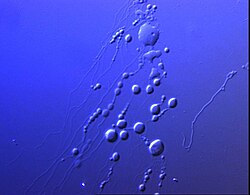
Back حويصلة (أحياء) Arabic Секреторно мехурче Bulgarian ভেসিকল (জীববিজ্ঞান এবং রসায়ন) Bengali/Bangla Vezikula BS Vesícula Catalan ڤێزیکل CKB Vezikul Czech Vesikel Danish Vesikel (Biologie) German Κυστίδιο Greek

In cell biology, a vesicle is a structure within or outside a cell, consisting of liquid or cytoplasm enclosed by a lipid bilayer. Vesicles form naturally during the processes of secretion (exocytosis), uptake (endocytosis), and the transport of materials within the plasma membrane. Alternatively, they may be prepared artificially, in which case they are called liposomes (not to be confused with lysosomes). If there is only one phospholipid bilayer, the vesicles are called unilamellar liposomes; otherwise they are called multilamellar liposomes.[1] The membrane enclosing the vesicle is also a lamellar phase, similar to that of the plasma membrane, and intracellular vesicles can fuse with the plasma membrane to release their contents outside the cell. Vesicles can also fuse with other organelles within the cell. A vesicle released from the cell is known as an extracellular vesicle.
Vesicles perform a variety of functions. Because it is separated from the cytosol, the inside of the vesicle can be made to be different from the cytosolic environment. For this reason, vesicles are a basic tool used by the cell for organizing cellular substances. Vesicles are involved in metabolism, transport, buoyancy control,[2] and temporary storage of food and enzymes. They can also act as chemical reaction chambers.

Closed structure formed by amphiphilic molecules that contains solvent (usually water).[3]
The 2013 Nobel Prize in Physiology or Medicine was shared by James Rothman, Randy Schekman and Thomas Südhof for their roles in elucidating (building upon earlier research, some of it by their mentors) the makeup and function of cell vesicles, especially in yeasts and in humans, including information on each vesicle's parts and how they are assembled. Vesicle dysfunction is thought to contribute to Alzheimer's disease, diabetes, some hard-to-treat cases of epilepsy, some cancers and immunological disorders and certain neurovascular conditions.[4][5]
- ^ Akbarzadeh A, Rezaei-Sadabady R, Davaran S, Joo SW, Zarghami N, Hanifehpour Y, Samiei M, Kouhi M, Nejati-Koshki K (February 2013). "Liposome: classification, preparation, and applications". Nanoscale Res Lett. 8 (1): 102. Bibcode:2013NRL.....8..102A. doi:10.1186/1556-276X-8-102. PMC 3599573. PMID 23432972.
- ^ Walsby AE (March 1994). "Gas vesicles". Microbiological Reviews. 58 (1): 94–144. doi:10.1128/mmbr.58.1.94-144.1994. PMC 372955. PMID 8177173.
- ^ Slomkowski S, Alemán JV, Gilbert RG, Hess M, Horie K, Jones RG, et al. (2011). "Terminology of polymers and polymerization processes in dispersed systems (IUPAC Recommendations 2011)" (PDF). Pure and Applied Chemistry. 83 (12): 2229–2259. doi:10.1351/PAC-REC-10-06-03. S2CID 96812603.
- ^ "Nobel medical prize goes to 2 Americans, 1 German". CNN. 2005-10-19. Retrieved 2013-10-09.
- ^ 2013 Nobel Prize in Physiology or Medicine, press release 2013-10-07
© MMXXIII Rich X Search. We shall prevail. All rights reserved. Rich X Search